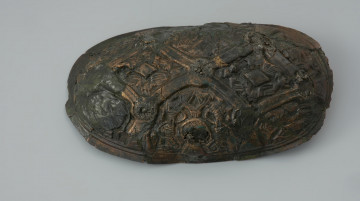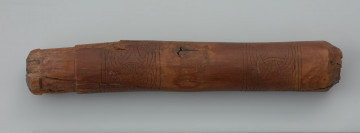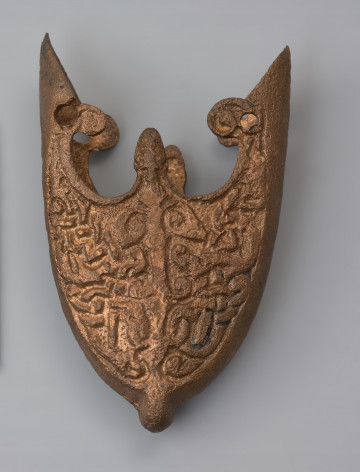
Tortoiseshell buckle
840 — 980
National Museum in Szczecin
Part of the collection: Middle Ages
The handle of an iron tool is a cylindrical wooden object with a rectangular hole on one end, where an awl for piercing holes in leather or a punch for carving ornaments on metal objects was inserted. It is distinguished by meticulous ornamentation in the form of a braid, as well as engraved lines, characteristic of the Scandinavian art of the Viking period known as Borre. The main decorative motifs of this style found on utilitarian objects such as tool handles, spoons, plates, and jewellery include ribbon braids forming the so-called Gaut-tangle pattern, as well as four-legged beasts and animals with their heads turned backwards. The style takes its name from the village of Borre in Norway, where gilded bronze bridle fittings decorated in this characteristic manner were discovered in one of the barrows dating back to the Viking period. Items decorated in the characteristic Borre style date back to the period from the 9th to the 2nd half of the 10th century, and outside Scandinavia, they have been in use until the 11th century. On the southern coast of the Baltic Sea, objects decorated in the Borre style are believed to be imported or manufactured by Scandinavian craftsmen, who came to the local craft and trade centres.
Grzegorz Durdyń
Author / creator
Dimensions
cały obiekt: height: 10.4 cm, diameter: 1.4 cm
Object type
tool
Technique
printing, planing
Material
wood
Origin / acquisition method
field research
Creation time / dating
Creation / finding place
Owner
Muzeum Narodowe w Szczecinie
Identification number
Location / status

840 — 980
National Museum in Szczecin

900 — 1100
National Museum in Szczecin

1176 — 1200
National Museum in Szczecin
DISCOVER this TOPIC
Museum of King Jan III's Palace at Wilanów
DISCOVER this PATH
Educational path